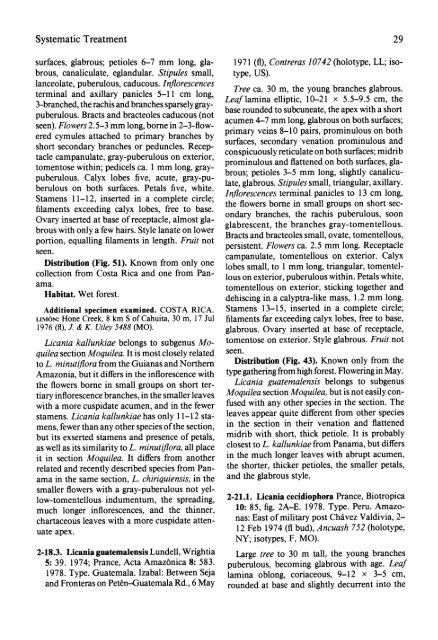flora neotropica - CNCFlora
flora neotropica - CNCFlora
flora neotropica - CNCFlora
You also want an ePaper? Increase the reach of your titles
YUMPU automatically turns print PDFs into web optimized ePapers that Google loves.
Systematic Treatment29<br />
surfaces, glabrous; petioles 6-7 mm long, glabrous,<br />
canaliculate, eglandular. Stipules small,<br />
lanceolate, puberulous, caducous. Inflorescences<br />
terminal and axillary panicles 5-11 cm long,<br />
3-branched, the rachis and branches sparsely gray-<br />
1971 (fl), Contreras 10742 (holotype, LL; iso-<br />
type, US).<br />
Tree ca. 30 m, the young branches glabrous.<br />
Leaf lamina elliptic, 10-21 x 5.5-9.5 cm, the<br />
base rounded to<br />
puberulous. Bracts and bracteoles caducous<br />
subcuneate, the apex with a short<br />
(not<br />
acumen 4-7 mm<br />
seen). Flowers 2.5-3 mm long, borne in 2-3-flow-<br />
long, glabrous on both surfaces;<br />
ered cymules attached to primary branches primary veins 8-10 pairs, prominulous on both<br />
by<br />
short secondary branches or surfaces, secondary venation prominulous and<br />
peduncles. Receptacle<br />
campanulate, gray-puberulous on conspicuously reticulate on both surfaces; midrib<br />
exterior,<br />
tomentose within; pedicels ca. 1 mm prominulous and flattened on both surfaces, glalong,graypuberulous.<br />
Calyx lobes<br />
brous; petioles 3-5 mm long, slightly canalicufive,<br />
acute, gray-puberulous<br />
on both surfaces. Petals five, white. late, glabrous. Stipules small, triangular, axillary.<br />
Stamens 11-12, inserted in a Inflorescences terminal panicles to 13 cm long,<br />
complete circle;<br />
the flowers borne in small<br />
filaments exceeding calyx lobes, free to base.<br />
groups on short sec-<br />
Ovary inserted at base of receptacle, almost ondary branches, the rachis puberulous, soon<br />
glabrous<br />
with only a few hairs. Style lanate on lower glabrescent, the branches gray-tomentellous.<br />
Bracts and bracteoles<br />
portion, equalling filaments in length. Fruit not<br />
small, ovate, tomentellous,<br />
seen.<br />
persistent. Flowers ca. 2.5 mm long. Receptacle<br />
campanulate, tomentellous on exterior. Calyx<br />
Distribution (Fig. 51). Known from only one<br />
lobes small, to 1 mm long, triangular, tomentelcollection<br />
from Costa Rica and one from Panlous<br />
on exterior, puberulous within. Petals white,<br />
ama.<br />
tomentellous on exterior, sticking together and<br />
Habitat. Wet forest.<br />
dehiscing in a calyptra-like mass, 1.2 mm long.<br />
Additional specimen examined. COSTA RICA. Stamens 13-15, inserted in a complete circle;<br />
LIMON: Hone Creek, 8 km S of Cahuita, 30 m, 17 Jul filaments far exceeding calyx lobes, free to base,<br />
1976 (fl), J. & K. Utley 5488 (MO).<br />
glabrous. Ovary inserted at base of receptacle,<br />
Licania kallunkiae belongs to subgenus Mo- tomentose on exterior. Style glabrous. Fruit not<br />
quilea section Moquilea. It is most closely related seen.<br />
to L. minuti<strong>flora</strong> from the Guianas and Northern Distribution (Fig. 43). Known only from the<br />
Amazonia, but it differs in the inflorescence with type gathering from high forest. Flowering in May.<br />
the flowers borne in small groups on short ter- Licania guatemalensis belongs to subgenus<br />
tiary inflorescence branches, in the smaller leaves Moquilea section Moquilea, but is not easily conwith<br />
a more cuspidate acumen, and in the fewer fused with any other species in the section. The<br />
stamens. Licania kallunkiae has only 11-12 sta- leaves appear quite different from other species<br />
mens, fewer than any other species of the section,<br />
in the section in their venation and flattened<br />
but its exserted stamens and presence of petals,<br />
midrib with short, thick petiole. It is probably<br />
as well as its similarity to L. minuti<strong>flora</strong>, all place<br />
closest to L. kallunkiae from Panama, but differs<br />
it in section Moquilea. It differs from another in the much longer leaves with abrupt acumen,<br />
related and recently described species from Pan- the shorter, thicker petioles, the smaller petals,<br />
ama in the same section, L. chiriquiensis, in the and the glabrous style.<br />
smaller flowers with a gray-puberulous not yellow-tomentellous<br />
indumentum, the spreading,<br />
2-21.1. Licania cecidiophora Prance, Biotropica<br />
much longer inflorescences, and the thinner,<br />
10: 85, fig. 2A-E. 1978. Type. Peru. Amazochartaceous<br />
leaves with a more cuspidate atten- nas: East of military post Chavez Valdivia, 2-<br />
uate 12<br />
apex.<br />
Feb 1974 (fl bud), Ancuash 752 (holotype,<br />
NY; isotypes, F, MO).<br />
2-18.3. Licania guatemalensis Lundell, Wrightia Large tree to 30 m tall, the young branches<br />
5: 39. 1974; Prance, Acta Amaz6nica 8: 583.<br />
puberulous, becoming glabrous with age. Leaf<br />
1978. Type. Guatemala. Izabal: Between Seja lamina oblong, coriaceous, 9-12 x 3-5 cm,<br />
and Fronteras on Peten-Guatemala Rd., 6 May rounded at base and slightly decurrent into the

















